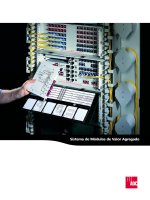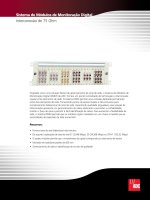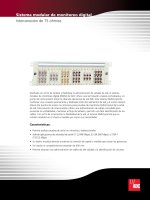Toplivnaja sistema dvigatelja evro 3
Bạn đang xem bản rút gọn của tài liệu. Xem và tải ngay bản đầy đủ của tài liệu tại đây (3.51 MB, 61 trang )
Welcome
to a technical overview of
Common Rail
Diesel Fuel Systems
presented by
Tony Kitchen
(AK Training)
Foreword
Tony Kitchen (AK Training) offers professional technical courses for those working in the motor industry
wanting to improve their knowledge and skills and who are serious about personal development. Courses
are based upon 25 years practical experience and extensive hands on technical knowledge of subject
matter (not possible to obtain from reading a book or watching a CD)!
A comprehensive programme of courses is available from AK Training. Courses run from regular venues in
the Milton Keynes, Northampton and Buckingham area. Courses can also be delivered on site at clients
premises anywhere in the UK. Overseas training services are also available. This presentation forms the
basis for a generic common rail diesel course which is now undergoing development and will be available
in the near future.
For further information about courses, course dates, fees, venues and all other enquiries including on site
and overseas training, please contact AK Training direct. In the meantime, please enjoy the following
presentation for your technical information.
AK Training
Telephone: 01908 579309 Mobile: 07968 842274
E-mail:
www.akautomotivetraining.co.uk
IMI Awards Approved Assessment Centre
IRTEC Approved Awards Assessment Centre
Motor Industry Professional Training
and Development
Common Rail Diesel Fuel Systems
Aims, objectives and disclaimer:
The aim of this presentation is to give a generic technical overview of the main features and
operating principles of the common rail diesel fuel injection system. The objectives are that
by the end of this presentation, you will have gained a working knowledge and
understanding of the fundamental principles of common rail diesel fuel systems.
Please bear in mind that all facts and figures quoted are intended to show typical examples
only for explanation purposes. Always refer to manufacturer technical data for exact system
specifications and repair procedures.
Finally this slide show does not include speaker notes. If you have any comments or would
like further information, please contact AK Training directly
Common Rail Diesel Fuel Systems
Advantages of common rail:
• Fuel pressure available on demand.....
• Higher injection pressures and finer atomization of fuel.....
• Injection pressure created independent of engine speed.....
• Multiple injections per cylinder combustion are possible.
Benefits of common rail:
• Reduction of overall exhaust emissions.....
• Reduction of particulate emissions.....
• Reduction of noise emissions.....
• Improved fuel efficiency.....
• Higher performance.
Common Rail Diesel Fuel Systems
Examples of typical common rail system maximum fuel pressures:
• Bosch:
Generation 1: up to 1350 Bar (19845 psi). Unijet
Generation 2: up to 1600 Bar (23520 psi) EDC 16
Generation 3: up to 2000 Bar + (29400 psi)
• Denso:
1st generation: up to 1450 Bar (21315 psi) ECD-U2P
2nd generation: 1800 Bar + (26460 psi) HP3/HP4
• Delphi
Multec: up to 2000 Bar
Direct acting diesel common rail system: up to 2000 Bar
Various systems differ in design, components layout and specific
functions. However, all operate in a similar way.
Bosch
EDC16
Denso
ECD-U2P
Common Rail Diesel Fuel Systems
The fuel system can be divided into three basic circuits
High pressure delivery
• Low pressure supply circuit
• High pressure delivery circuit
Low pressure
supply
Fuel leak back and return
Example: Bosch EDC16
• Fuel leak back and return
Common Rail Diesel Fuel Systems
Components overview (example: Bosch EDC 16)
Fuel metering control valve
High pressure
fuel pump
Fuel rail pressure control valve
Fuel rail pressure sensor
Fuel filter
Common rail
Electric fuel
pump
ECM
Low pressure
High pressure
Leak back/return
Injectors
Common Rail Diesel Fuel Systems
High pressure fuel pump
The High pressure pump is the interface between the low pressure
and the high pressure side of the fuel system.
Bosch CP3
Bosch CP1
Denso HP4
Denso HP3
Basic function:
To ensure that enough fuel is delivered at sufficient pressure across
the engine’s entire operating range. This includes delivery of sufficient
fuel for a rapid engine start and pressure increase in the rail.
Common Rail Diesel Fuel Systems
High pressure fuel pump
Fuel return
Fuel supply inlet
Example:
Bosch CP3
Fuel metering control
valve (solenoid)
High pressure
fuel outlet
Gear type transfer
pump
Pump shaft with
eccentric cam
Polygon ring
Pressure valve
Suction valve
The pump has several pumping chambers
Common Rail Diesel Fuel Systems
High pressure fuel pump
3
2
3
4
Pumping
chamber
1
Transfer pump
1: Pressure valve
2: Suction valve
3: Low pressure (yellow)
4: High pressure (red)
Fuel metering valve
Common Rail Diesel Fuel Systems
High pressure fuel pump
Fuel metering valve
Transfer pump
Transfer pump supplies fuel from the fuel tank to the
pumping chambers of the high pressure pump.
Fuel metering valve regulates the fuel intake volume
to the pumping chambers of the high pressure pump.
Common Rail Diesel Fuel Systems
High pressure fuel pump
Pump shaft
Polygon ring
Pumping piston
Eccentric cam
3 pumping pistons are operated by a polygon
ring on an eccentric cam on the pump shaft.
Common Rail Diesel Fuel Systems
High pressure fuel pump
Pump shaft
Polygon ring
Pumping piston
Eccentric cam
As the pump rotates, the polygon ring moves in
a circular motion to operate the pump pistons.
Common Rail Diesel Fuel Systems
Transfer pump
Fuel inlet port
Fuel outlet port
Trochoidal type (Denso HP3)
Gear type (Bosch CP3)
An electric pre supply pump in fuel tank may be used
instead of a transfer pump. Some systems may use a
combination of electric pump and transfer pump.
Common Rail Diesel Fuel Systems
Fuel metering control valve
Example:
Bosch CP3
• Located at back of high pressure pump.
Fuel inlet
• Controls the fuel intake volume to the pump.
• Receives battery voltage supply from engine ECM.
Fuel outlet
• Energized by ECM via negatively triggered PWM.
• Operating frequency: approximately 180Hz.
Common Rail Diesel Fuel Systems
Fuel metering control valve
When solenoid de energized, valve is open
Fuel inlet
Fuel outlet
= LOW fuel volume intake to pump.
When solenoid energized, valve is closed
= HIGH fuel volume intake to pump.
The fuel volume intake is controlled as follows.....
Common Rail Diesel Fuel Systems
Fuel volume intake control
1
2
13
3
4
12
5
11
6
7
8
10
9
1
2
3
4
5
6
7
8
9
10
11
12
13
Pump piston
Pressure valve
to common rail
Suction valve
Return
Safety valve
Feed (from the tank)
Gear pump
Fuel metering control
valve
Throttle bore
Control piston
Lubricating-oil bore
High-pressure pump
Valve de energized OPEN
More fuel returns to tank
LOW fuel volume to pump
Common Rail Diesel Fuel Systems
Fuel volume intake control
1
2
13
3
4
12
5
11
6
7
8
10
9
1
2
3
4
5
6
7
8
9
10
11
12
13
Pump piston
Pressure valve
to common rail
Suction valve
Return
Safety valve
Feed (from the tank)
Gear pump
Fuel metering control
valve
Throttle bore
Control piston
Lubricating-oil bore
High-pressure pump
Valve energized CLOSED
Less fuel returns to tank
HIGH fuel volume to pump
Common Rail Diesel Fuel Systems
Advantages of fuel intake volume regulation:
• Only the required volume of fuel is supplied to the common rail from
the high pressure pump.....
• Reduced fuel flow around system results in lower fuel return flow
temperature.....
• Reduced parasitic load on engine from high pressure pump contributes
towards further reductions in exhaust emissions.
Low volume
High volume
Common Rail Diesel Fuel Systems
Fuel metering control valve failure symptoms and diagnosis
Solenoid circuit monitored by engine ECM.
If an open or short circuit is detected:
Engine stops or will not start.
DTC stored and MIL illuminated.
Mechanical failure of the metering
control valve does not necessarily
prevent the engine from starting.
Mechanical faults can cause DTC’s relating to positive
or negative rail pressure deviations.
Common Rail Diesel Fuel Systems
High pressure regulator valve
System variant.
Fitted to back of HP pump.
Controls high pressure fuel
delivery to common rail.
High pressure fuel
delivery to common tail
Excess fuel returns to
tank.
Fuel cooler required to cool
return fuel flow.
Low pressure fuel inlet
(from fuel tank)
Fuel return
(to fuel tank)
High pressure
regulator valve
Common Rail Diesel Fuel Systems
High pressure accumulator (common rail)
Fuel is supplied to the common rail at high pressure from the high
pressure pump.
The rail stores the fuel and distributes it to the individual injectors.
It also damps pressure vibrations caused by the high pressure pump
and injection processes.
Typical volume of fuel held in common rail: 16 – 20cm³.
Common Rail Diesel Fuel Systems
High pressure accumulator (common rail)
Typical fuel rail pressure with engine idling and at running temperature:
approximately between 300 – 400 Bar (4410 – 5880 psi)
Typical maximum possible fuel rail pressure:
approximately between 1600 – 2000 Bar (23520 – 28400 psi)
Common Rail Diesel Fuel Systems
High pressure accumulator (common rail)
Typical fuel rail pressure with engine idling and at running temperature:
approximately between 300 – 400 Bar (4410 – 5880 psi)
Health and safety
Due to the extremely high working fuel pressures in the common
rail fuel system, NEVER slacken fuel or injector pipes or try to
disconnect components of the fuel system whilst the engine is
running and high pressure is present in the system!
Typical maximum possible fuel rail pressure:
approximately between 1600 – 2000 Bar (23520 – 28400 psi)
Common Rail Diesel Fuel Systems
Fuel rail pressure sensor
Fuel pressure sensor
A fuel rail pressure sensor is located on the fuel rail.









